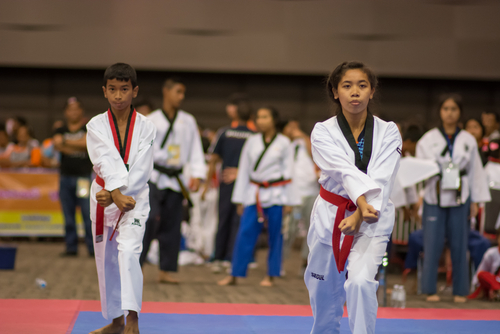Taekwondo gear

Image credit: Shutterstock.com
A largely individual sport, taekwondo requires a few types of personal equipment for competition.
Dobok
The uniform worn by a participant is known as a dobok, and is usually white in colour, but some uniforms may also be black. A black dobok is usually worn by instructors or special teams such as demonstration teams.
The dobok is tied around the waist with a coloured belt, and also features a matching set of trousers.
Belt
One of the most distinguishing features of taekwondo is the belt. Participants have to wear a belt that reflects their rank and level they are at, with the darker colours usually indicating a higher rank. Beginners typically wear a white belt, and switch it for darker colours once they have passed their promotion tests.
Protective Padding
While not commonly used in training, protective padding is required during a sparring competition. The different forms of padding include shin and forearm guards, trunk protectors and head protectors.
Much like a padded helmet, the head protector resembles the ones used in water polo. It covers both ears to protect the competitor from sustaining any serious ear and head injury during the competition.
The trunk protectors, also known as hogu, are wrapped around an individual’s chest to protect his torso and is considered one of the most important protective equipment in the sport. This is because the chest is one of the areas that endures the most impact during competition, with opponents frequently kicking and hitting the chest with the fists.
Less important but still required are the shin and forearm guards, which protects the participant from sustaining any injuries caused by kicks and hits to these areas. Male competitors also usually wear a protective groin guard, to prevent their groin from sustaining any serious injuries during the competition.
Shoes
Taekwondo is frequently practiced barefooted, but some competitions and trainings require footwear. Taekwondo shoes are the most commonly worn as a form of protection while kicking at an opponent’s hogu, which can cause injuries. However, most taekwondo practitioners prefer to train barefooted as it improves their posture during competition, conditions their feet and strengthens the muscles to provide a stronger kick.
Keen to start your Taekwondo journey? Check out ActiveSG Martial Arts Club for our latest classes and workshops!
To receive the latest updates on the happenings in the Singapore sports scene, or to find out more about some of the latest programmes on offer at ActiveSG, like our Facebook page here.





![ActiveSG Academies and Clubs Logo (Solid Colour)[8647]](https://www.activesgcircle.gov.sg/hs-fs/hubfs/ActiveSG%20Circle%202023Theme/images/ActiveSG%20Academies%20and%20Clubs%20Logo%20(Solid%20Colour)%5B8647%5D.png?width=150&height=65&name=ActiveSG%20Academies%20and%20Clubs%20Logo%20(Solid%20Colour)%5B8647%5D.png)




-01.png?width=200&height=141&name=Team%20Singapore%20Logo%20(Red)-01.png)



